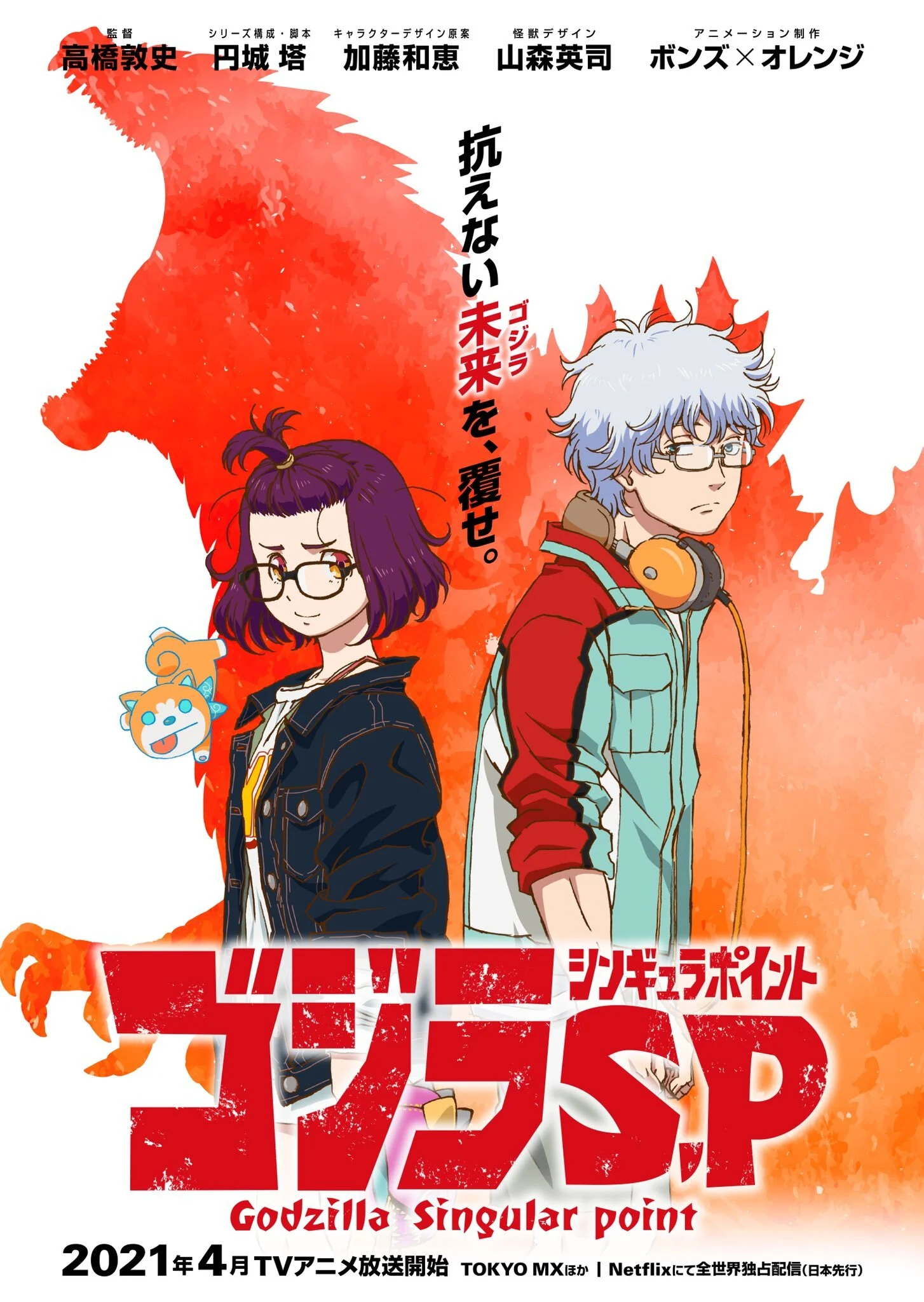The Confusing World of Godzilla: Singular Point
Shin Godzilla
Since the late 1990s, there’s never been a better time to be a Godzilla fan. With the recent release of Godzilla VS. Kong on home video, everyone can enjoy the entire MonsterVerse saga from beginning to end – an excellent quadrilogy of western takes on kaiju. However, the country that Godzilla first came from hasn’t been slouching in their productions of the titanic icon. In 2016, parent company Toho released Shin Godzilla to critical and commercial acclaim. And as a personal note, that film is one of my favorites in the series. Then from 2017 to 2018, a trilogy of Godzilla anime films were released: Godzilla: Planet of the Monsters, Godzilla: City on the Edge of Battle and Godzilla: The Planet Eater. Conversely to Shin Godzilla, these films were met with such a negative reaction that I’ve yet to watch all three of them, despite my superfan status. So, you can imagine my excitement and apprehension when just last year we were made aware of a new anime project in the works: a full-fledged anime series by the name of Godzilla: Singular Point.
Mei Kamino
Released just last month on Netflix, Godzilla: Singular Point takes cues from Roland Emmerich’s disaster films in that it has a cast of over a dozen characters for us to follow. However, despite the anime’s 13 episode run, the only characters that truly felt important were Mei Kamino, a brilliant graduate student who unravels the scientific nature of the kaiju, Yun Arikawa, an employee of the Otaki Factory tech company and a brilliant mind in his own right, and Goro Otaki, head of the Otaki Factory and creator of fighting robot Jet Jaguar. These three characters work together to decipher a mystery seemingly hundreds of years old, as well as to repel the sudden appearance of terrifying kaiju in Japan.
Rodan
There’s a lot that Godzilla: Singular Point does well. The first five episodes in particular do a phenomenal job of setting up a bizarre mystery just begging to be solved, with a mysterious broadcast going out that attracts the first of the kaiju, Rodan, to the mainland. The signal itself coming from a Godzilla skeleton in the basement of the Misakioku Research Institute. As more kaiju appear, the very nature of these creatures is examined in great detail.
Godzilla: Singular Point redesigns all of the kaiju it represents here, and the new looks for each of the kaiju really is a highlight of the series. Rodan is a particular standout, as its new design is not only striking with its more Pterosaur-like look and psychedelic color scheme, but in the way it evolves over the course of the series. Rodan’s evolution is closely tied to the mystery of the series, and it keeps you guessing.
Angruirus
Another kaiju high point for me was the kaiju known as Anguirus. Typically, Anguirus plays second fiddle to Godzilla, usually getting defeated or outshined by the main monster. However, in Singular Point the kaiju gets a whole 2-episode arc dedicated to him, and it doesn’t disappoint. His cool new design is complemented by new, never before seen abilities that really make Anguirus a dangerous and interesting monster.
Jet Jaguar
Finally, while not strictly a kaiju, the aforementioned Jet Jaguar is another great addition to Godzilla: Singular Point. Jet Jaguar hasn’t been seen on film since 1973’s Godzilla VS. Megalon, so it’s great to see him return here. Like the kaiju, Jet Jaguar also evolves over the course of the series, taking on new and interesting forms to combat the growing kaiju menace.
Godzilla: Singular Point as an anime looks phenomenal, thanks to the two studios that worked on it. Studio Bones produced all the 2D scenes, while Studio Orange did all of the 3D characters (AKA the kaiju). For those unaware, Bones and Orange are two of the top anime studios around today, with Bones, responsible for the smash hit My Hero Academia and Orange having brought BEASTARS to life in a very impressive way. Therefore, to see them collaborate on my favorite franchise was a true delight, and they absolutely delivered on a visual level.
Bish
The music for Godzilla: Singular Point is also a bright spot for the series. J-Rock group BiSH’s opening theme “In Case…” has been stuck in my head since I first heard it, and the remixed versions of Godzilla’s theme rival Bear McCreary’s masterwork that is the soundtrack to Godzilla: King of the Monsters.
With all that said, Godzilla: Singular Point is far from a perfect experience. While the first five episodes draw you in with its stellar animation and unique ancient mystery, it’s soon drowned out by more technobabble than you’d see in a typical episode of Star Trek: The Next Generation. Now, this on its own wouldn’t be so bad, but the problem is that unlike Star Trek, the high concept ideas are never explained with a simple metaphor.
It also doesn’t help that every single character in Godzilla: Singular Point is smart. That may sound silly, but having every character understand what the genius ones say at face value is frustrating when as the audience, I can’t. This is why the anime series Dr. Stone has a plethora of characters less intelligent than its main character Senku, so that he has to dumb down his explanations of the science for us as the audience to understand. Without that dumber character, we, as the audience, are left out of the loop, and frankly, feeling rather stupid. This was the one time in a Godzilla production I felt the need to rewatch it, not because it was so good, but simply because I didn’t understand all the science being thrown at me. And honestly, even after a second watch I still find myself confused.
Case in point – I still don’t even understand what a Singular Point is.
The lack of comprehension seriously impacts my enjoyment of Godzilla: Singular Point, and that lack of understanding extends to the titular Godzilla himself. While making a brief appearance at the end of episode 3, Godzilla doesn’t make a formal appearance in the series until episode 7, over halfway through the first season. Granted, many will argue that Godzilla takes a long time to show up, as was the case when defending Godzilla (2014). However, in that film it only took Godzilla an hour to show up – here, it takes almost three times that! It’s quite frustrating to be watching a series called Godzilla: Singular Point when it so clearly lacks Godzilla.
Titansaurous
Additionally, when Godzilla does show up, he looks far less like Godzilla and more like another kaiju, Titanosaurus. While Godzilla’s design varying is nothing new (Shin Godzilla did it to great effect after all), it’s aggravating when it’s so close to another existing monster’s design. As Godzilla evolves, he continues to change into new forms that resemble other monsters more than they do Godzilla, like Varan and Gorosaurus. While I can appreciate this as an homage, it’s disappointing that the creators of the anime couldn’t come up with anything more original for Godzilla’s design. In fact, many times I found myself thinking that if the Godzilla theme wasn’t blaring during the scenes with this monster, I’d have thought it was something entirely different.
Goro Otaki
Another personal pet peeve of mine when it comes to Godzilla: Singular Point is the anime’s seeming aversion to the thing that people come to Godzilla for the most – the giant monster fights. While it’s true there are many battles between Jet Jaguar and the various kaiju, these are far smaller in scale and not the fights we come to expect from this franchise. There are several times when Godzilla will come to clash with other giant monsters, but they end within a minute or so of them beginning. It’s extremely frustrating to be teased and then denied the very thing I watch the films for.
Circling back a bit, another problem I had with Godzilla: Singular Point were its flat characters. Due to the disaster movie style “cast of hundreds”, there’s really no time to explore any of the people the anime introduces to us. Mei Kamino and Yun Arikawa are two of the dullest characters I’ve ever experienced in an anime, not because they don’t do anything, but because they are slaves to the script, which constantly wants them to be talking about the monsters instead of dealing with them. And again, due to all the technobabble, even when they’re talking about the monsters, I can’t understand them. Maybe this is why I gravitated so much towards Goro Otaki, the eccentric old man who just wants to defeat the kaiju, and doesn’t care where they came from or why.
Although, if I were a more insightful man, one could say that the series is making fun of that set of ideals by making the character whose priorities are in line with so much of the fanbase an old man. It’s as if Godzilla: Singular Point is trying to say that my way of enjoying these monsters is old, behind the times and the way the kids are doing things with their overwrought, under explained theory is the way to go. But then, I’m probably overthinking things here.
Overall, Godzilla: Singular Point is a mixed bag. It introduces a lot of interesting mysteries and ideas, and gives a lot of the kaiju a very refreshing redesign. However, its insistence on focusing on the science and theory of kaiju simply stops me from being able to enjoy it to the fullest. I give Godzilla: Singular Point a 7/10.






